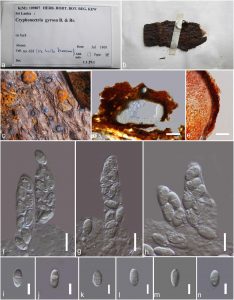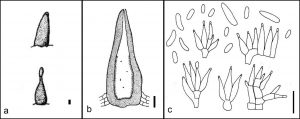Amphilogia gyrosa (Berk. & Broome) Gryzenh. et al., in Gryzenhout et al., Taxon 54(4): 1017 (2005a).
Saprobic on woody barks of Elaeocarpus glandulifer Mast. Sexual morph: Stromata 660–950 µm diam., often occurring in cracks, often confluent, pulvinate, erumpent, slightly immersed to superficial, orange, well-developed stromatic tissue, prosenchymatous at the center, pseudoparenchyma at the edges, orange, up to 22 perithecia in a stroma. Perithecia 460–500 µm high, 340–400 µm diam., surrounded with fungal tissue or with bases touching the host tissue, diatrypoid, globose to subglobose. Peridium 17–21 µm thick, black. Perithecial necks 440 µm long, 100–200 µm wide, periphysate, black, slender, breaking through the stromatal surface as papillae or long cylindrical beaks covered with orange tissue. Asci 46–52 × 7–8 µm, fusoid, floating freely in the perithecial cavity, stipitate only when immature, unitunicate with non-amyloid, refractive apical ring, 8-spored, biseriate. Ascospores 9–12 × 4–5 µm , oval, hyaline, containing one or two irregularly spaced septa. Asexual morph: Conidiomata 400–890 µm high, 100–370 µm diam., separate or above the ascostromata, also appearing as locules inside ascostromata, individual conidiomata unilocular, orange, superficial, conical to pyriform to fluted, conidiomatal tissue pseudoparenchymatous. Conidiophores 13–19 µm long, branched irregularly, cells delimited by septa or not, hyaline. Conidiogenous cells phialidic, determinate, branches arising beneath a septum, cylindrical to flask-shaped with attenuated apices, 1.5–2.5 µm wide, collarette and periclinal thickening inconspicuous. Conidia 3–12 × 1.5–3.5 µm , non-septate, oblong to slightly curved, hyaline (description based on Gryzenhout et al. 2005a).
Material examined: SRI LANKA, on bark of Elaeocarpus glandulifer (Hook.) Mast. (Elaeocarpaceae), July 1868, Thwaites G.H.K. (638), K (M) 109807 holotype (K).
Notes: Amphilogia was introduced by Gryzenhout et al. (2005) to accommodate a fungal strain named as ‘‘Cryphonectria gyrosa (CMW 10471/CRY 1551)’’ that occurs on Elaeocarpus glandulifer (Hook.) Mast. in Sri Lanka. Hence, Gryzenhout et al. (2005a) designated this specimen as the generic type material and it was renamed as Amphilogia gyrosa. This strain morphologically differs from other genera in Cryphonectriaceae in having superficial conical conidiomata, conidia of variable size and ascospores with one to three septa. Gryzenhout et al. (2005a) reported another strain (CMW 10469) from New Zealand which is morphologically and phylogenetically similar, but distinct from A. gyrosa and this second strain introduced as A. major Gryzenhout, Glen & M. J. Wingf.
Fig. 1 Amphilogia gyrosa (K (M) 109807). A, b Herbarium specimens. c Ascostromata on substrate. d Vertical section of ascomata. e Peridium. f-h Asci. i–n Ascospores. Scale Bars: d = 100 µm, e = 25 µm, f–h = 10 µm, i–n = 5 µm
Fig. 2 Amphilogia gyrosa (asexual morph; redrawn from Gryzenhout et al. 2005a). a Conidiomata on bark. b Vertical section of stroma. c Conidiophores, conidiogenous cells and conidia. Scale bars: a, b = 100 µm, c = 10 µm.


